How Much The Glased Cake
Few things are more satisfying than covering a cake in mirror glaze. Watching it slowly run downwardly the sides of the block, covering every inch of buttercream is so captivating. I've made a few mirror glaze cakes in the past, merely this summertime I wanted to make an ocean-inspired bluish mirror glaze cake.
With the help of a few different shades of blue and a bright mirror coat, this cake gives off total beach vibes!!
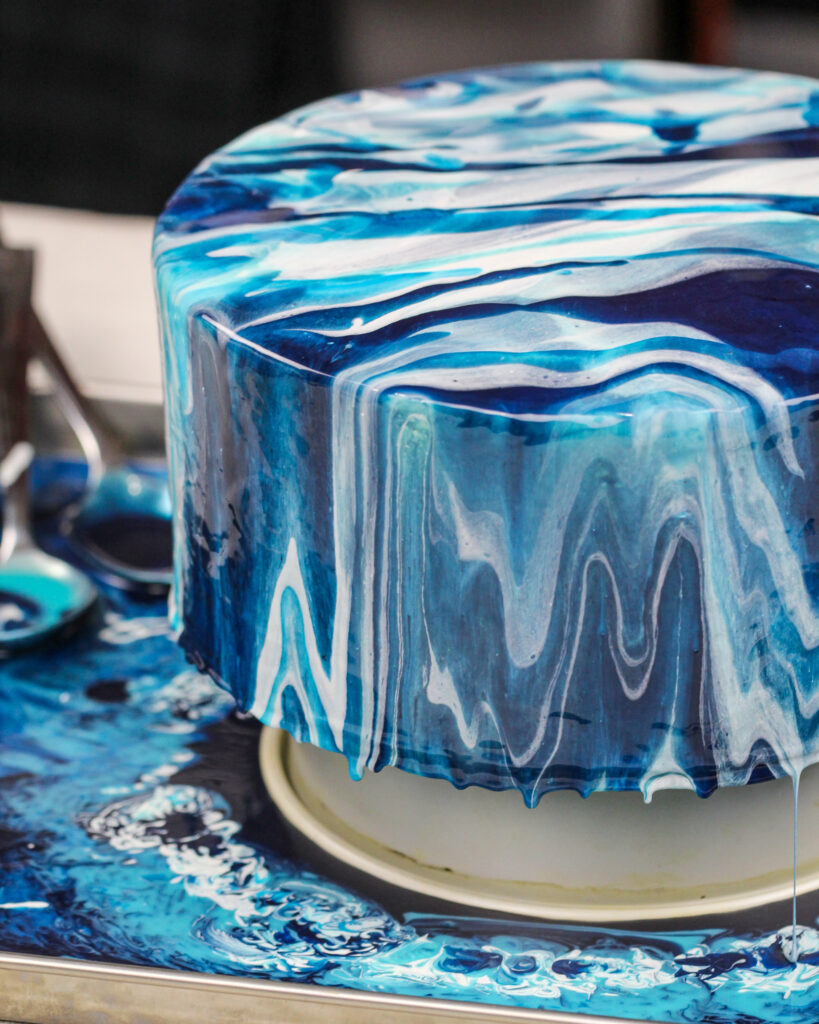
What Is Mirror Glaze?
At the base of every mirror glaze recipe, sugar and gelatin are the key ingredients.
Most recipes heat the mixture to allow the gelatin to deliquesce and combine with the other ingredients. The coat is and so immune to cool a bit before being poured over a chilled cake.
A lot of what gives the mirror glaze its shine is it beingness poured at the right temperature. I find that pouring my mirror glaze recipe at about 95 degrees F is the sugariness spot.
At this temperature the glaze is thin enough to be easily poured over the cake, simply thick enough to set on the block and continue it's vibrant colour.

What Does this Blue Mirror Coat Taste Similar?
My mirror glaze recipe includes a couple dissimilar ingredients that arrive unique and (in my stance) make it taste meliorate than some classic mirror glaze recipes.
The biggest difference? White chocolate. I don't know if yous've ever tasted apparently gelatin (or even smelled it), but it is but disgusting.
Every time I mix patently gelatin with water to allow information technology bloom, my gag reflex kicks in.
With that beingness said, I wanted to add together something to this recipe to cover that season. That's where the white chocolate and sweetened condensed milk come in.
These are the primary flavors of this mirror glaze, and they give the glaze a sweet, subtle sense of taste that pairs well with vanilla buttercream.
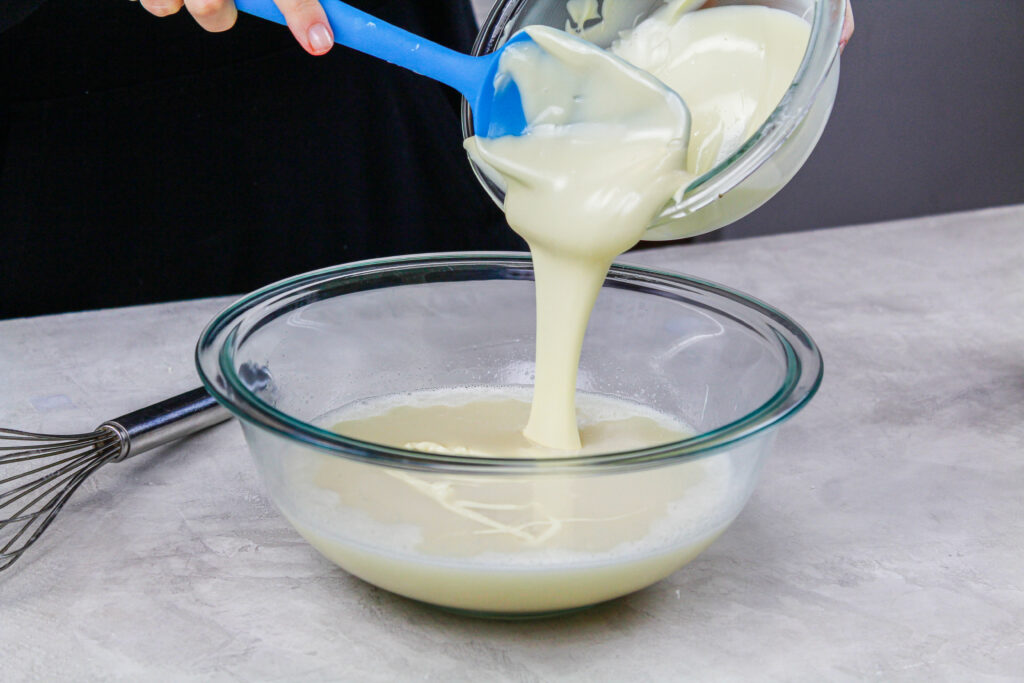
By adding in both of these ingredients, you're likewise giving the glaze a whitish base, which makes it easier to colour.
These ingredients also make the mirror glaze a tiny bit thicker, and more forgiving. It covers the cake in a thicker layer of glaze that a traditional mirror glaze.
How Much Mirror Coat Does One Batch Brand?
This recipe makes enough glaze to cover i, eight-inch layer cake.
While this technique is cute to make, it involves pouring tons of glaze over the cake. This is necessary to make certain the cake is fully covered in glaze.
You lot can try to salvage the glaze that runs off, but it can be more difficult to reuse once the colors combine.
I rarely reuse mirror glaze once its been poured, only you tin refrigerate leftover coat in an airtight container and reheat it to use it again.
How to Color this Blue Mirror Glaze
While this bluish mirror glaze cake is sea-themed, yous can create so many dissimilar looks with different colors.
When creating different colors of glaze, it's super important that you use gel food coloring to color this coat. I used navy, royal blue, and sky bluish gel food coloring to make the dissimilar colored glazes poured over this block.
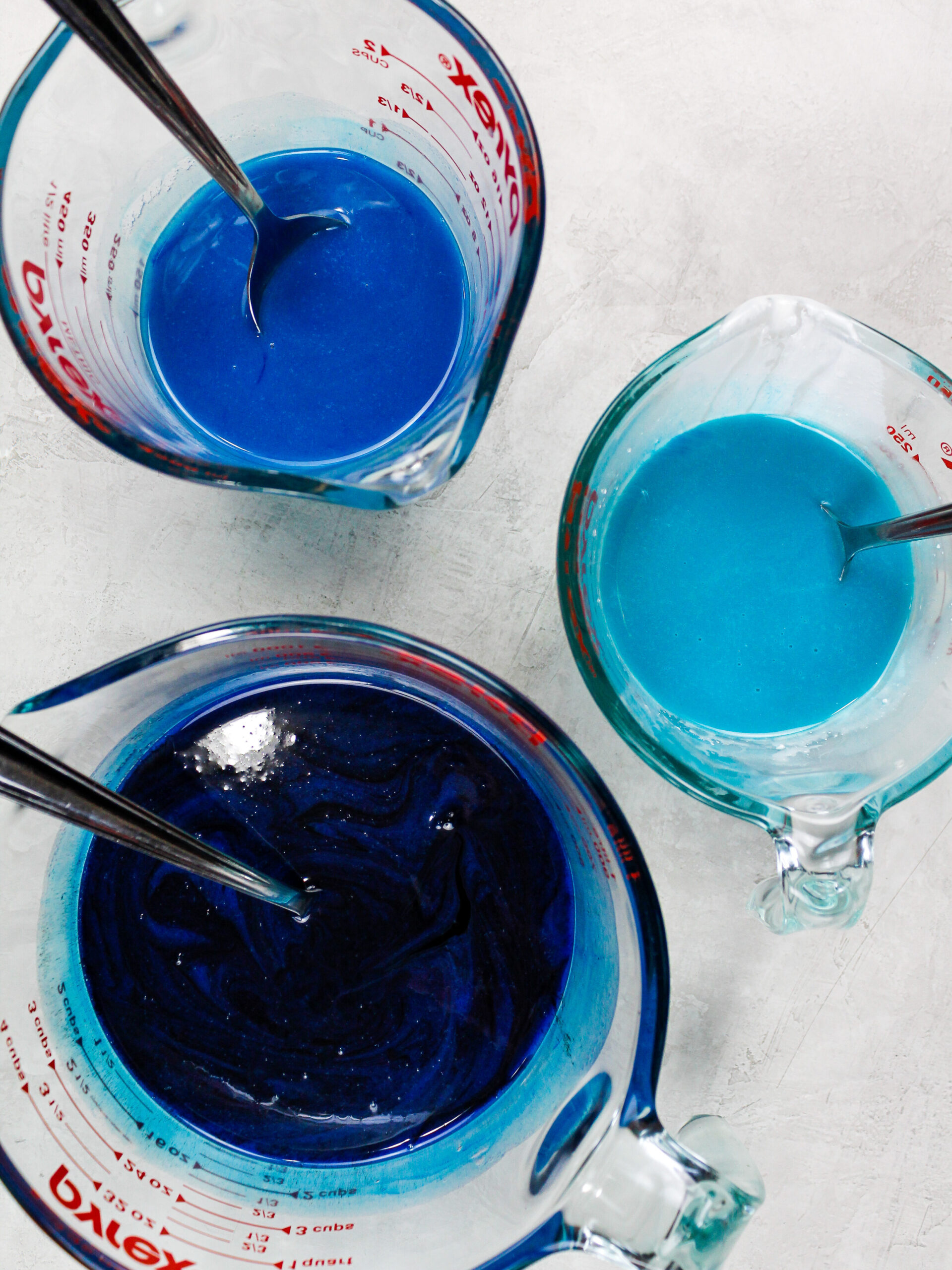
Gel nutrient coloring creates vibrant shades, because it is a lot more full-bodied than liquid nutrient coloring. This also means y'all don't accept to utilize much to get the color you lot're afterward.
If you try to employ liquid food coloring, you will have to employ a ton to get bright colors, and this can throw off the consistency of the glaze.
To make the bright white mirror coat I used a tiny bit of titanium dioxide!! its name makes it audio a bit intimidating, but it's really just a vegan whitening agent.
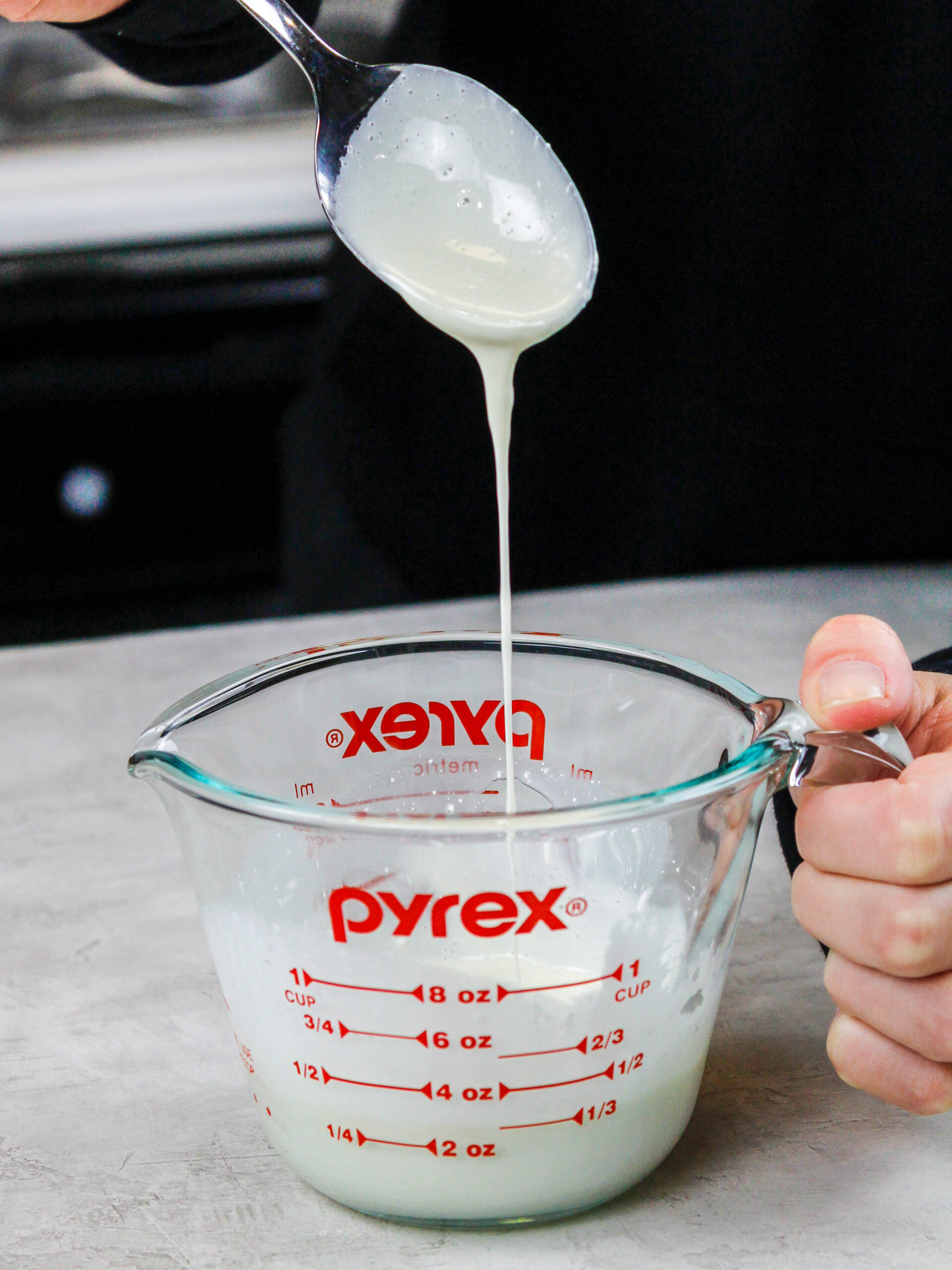
You tin can also employ white gel nutrient coloring, but information technology won't give you quite as bright of white color.
The Best Mode to Pour Mirror Glaze Over a Chilled Cake
Now that we've covered everything you need to know about mirror glaze, let's talk nigh actually pouring the mirror glaze onto a block!
Once you've frosted and chilled your buttercream cake, remove it from the refrigerator or freezer and place the cake on a round object on top of a large, rimmed baking sheet to catch the run-off coat.
I like to rest the cake on a small block pan or a wide, short glass.

Begin pouring the darkest glaze onto the center of the cake, then slowly work your way out to the edges. Once the cake is fully covered, drizzle the lighter colors over the cake to create a beautiful marbled look.
Let the coat continue to drip for nigh 10 minutes, and then use an starting time spatula to scrape abroad any drips from the block lath.
The glaze should be mostly set. Identify the cake in the refrigerator if you don't plan to eat it inside a few hours.
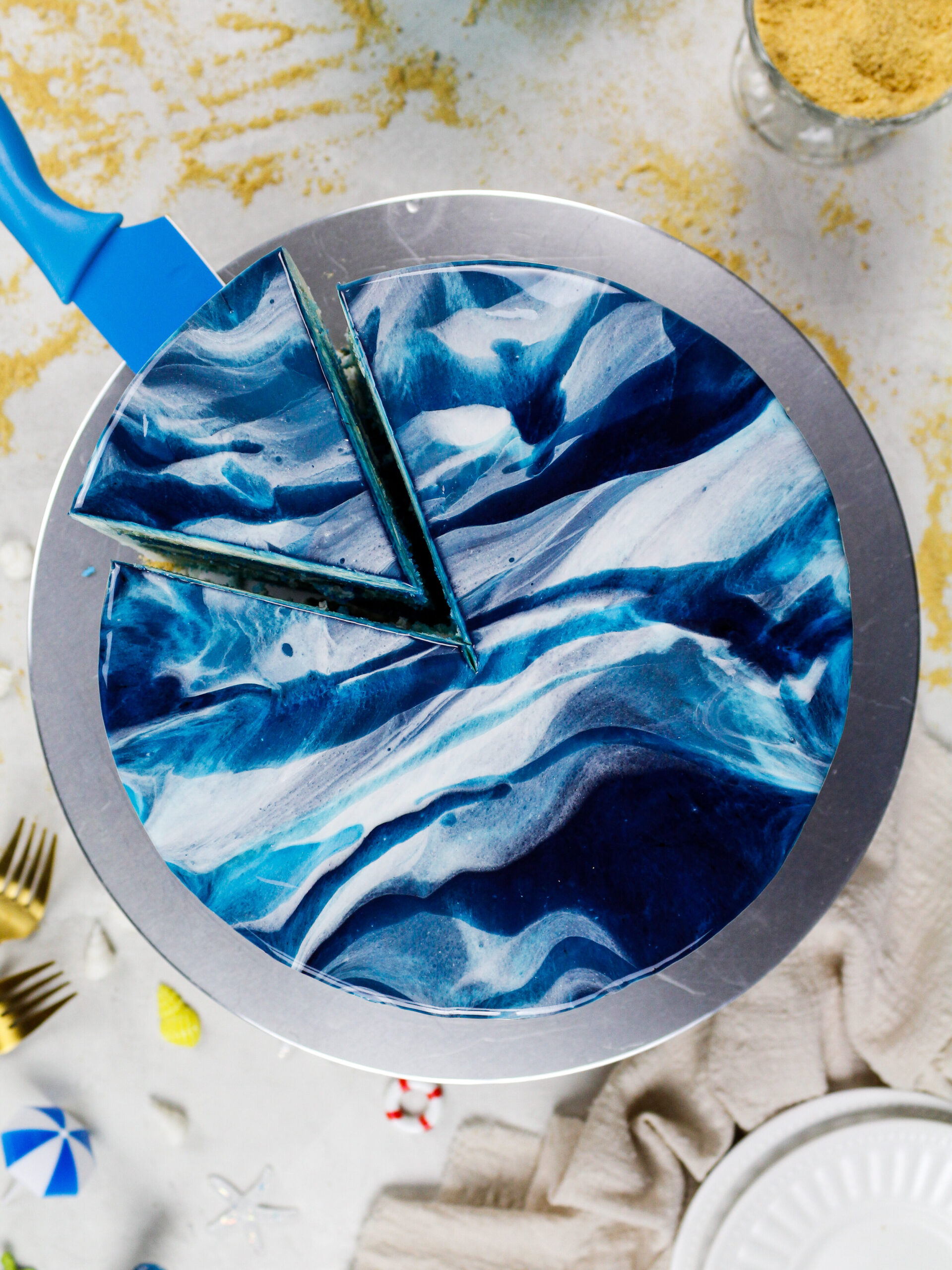
Boosted Tips for Making the All-time Mirror Glaze Cake:
- This recipe can be used on whatever type of buttercream block every bit long as it'south properly chilled.
- If possible, make the block on a cake board the same size as the block layers to permit the glaze to drip directly off the bottom of the cake.
- Don't use this mirror coat recipe on fondant! It tin do weird things to the fondant, and create a goopy mess.
- I prefer using mini white chocolate fries, merely any white chocolate chip (or finely chopped white chocolate bar) will work.
- You glaze should be thin enough to pour over over your cake, but thick enough that information technology is opaque and has a vibrant color. If you start to cascade and information technology seems to thick or thin, adjust the temperature to get information technology to the consistency.
- Exercise non use flavored jello in identify of the unflavored gelatin in this recipe.
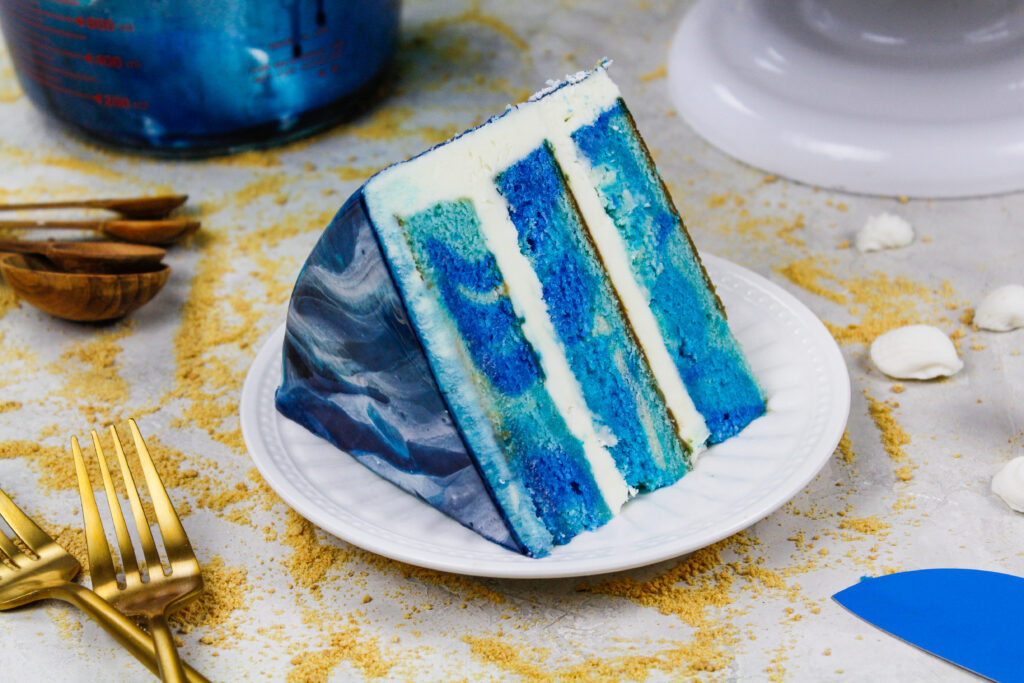
Making This Cake in Accelerate & Storage Tips:
- If you programme to eat the block within a few hours after pouring the glaze, leave information technology out at room temp.
- If you pour the coat in advance, store the cake in the fridge. Remove the block from the fridge a couple hours before you lot plan to cut into information technology.
- Make this mirror glaze ahead of time or salve leftovers! Once information technology'south fabricated, wrap the bowl with plastic wrap store in the refrigerator for up to a week.
- To use chilled glaze, heat the bowl in to the microwave for 15-20 second intervals until it reaches the right consistency
- Apply leftover glaze to elevation cupcakes, cookies, or even ice cream!
Other Recipes You lot Might Like:
-
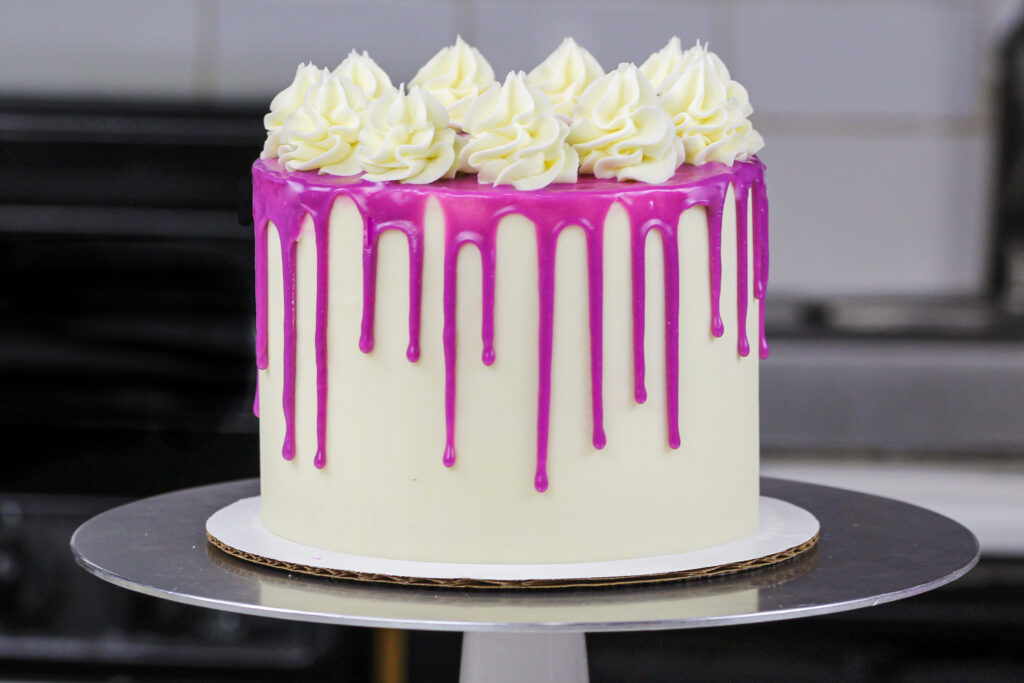
How to Brand a Baste Cake -
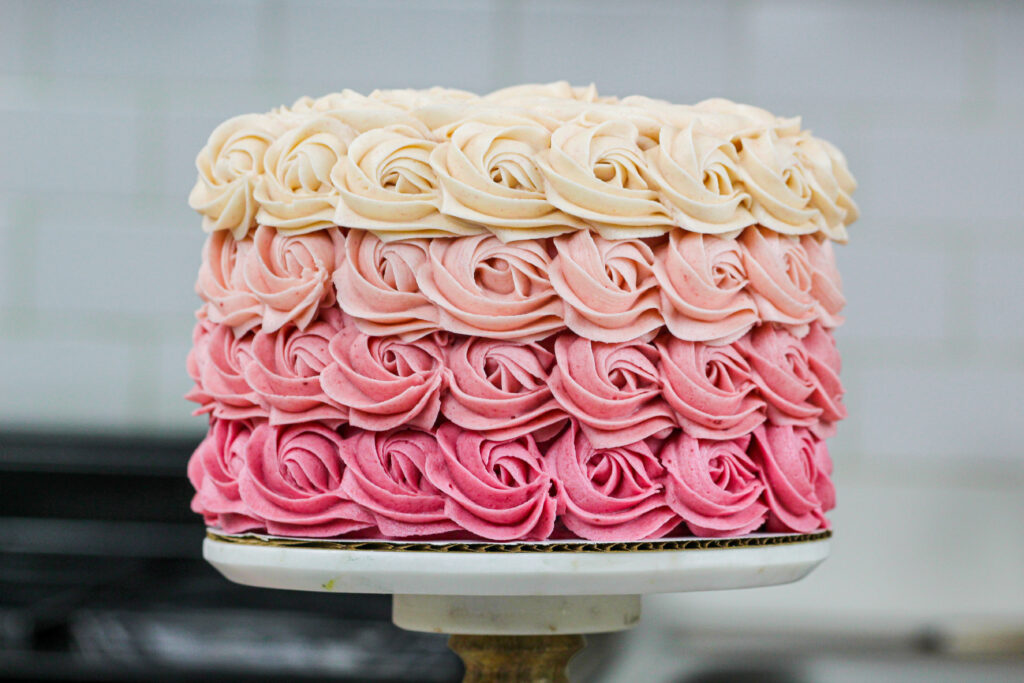
Ombre Rosette Cake -
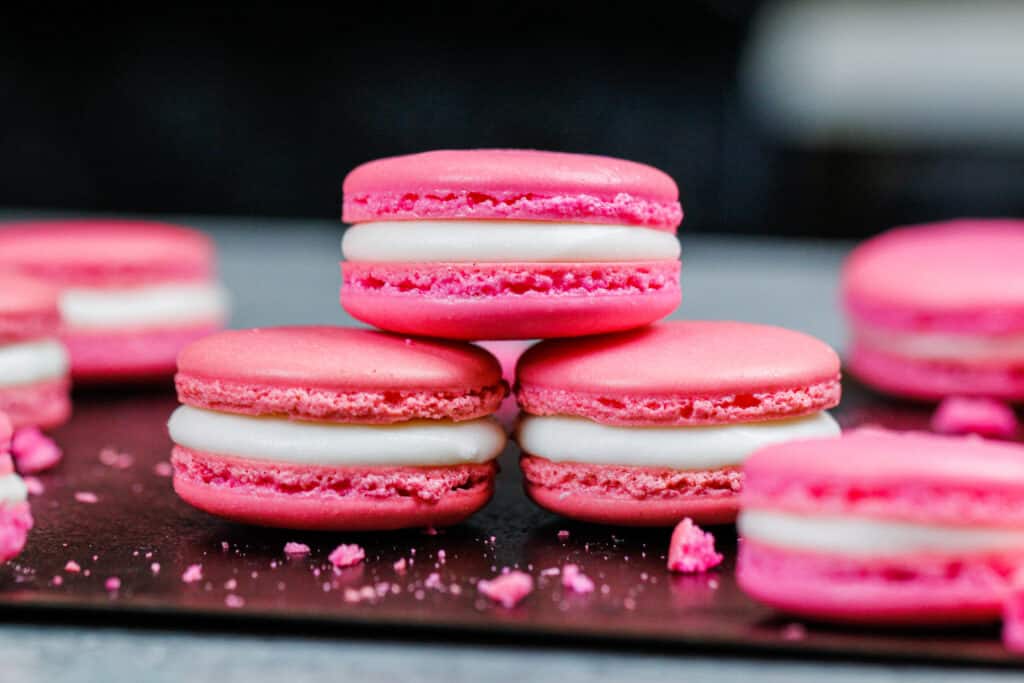
French Macarons -
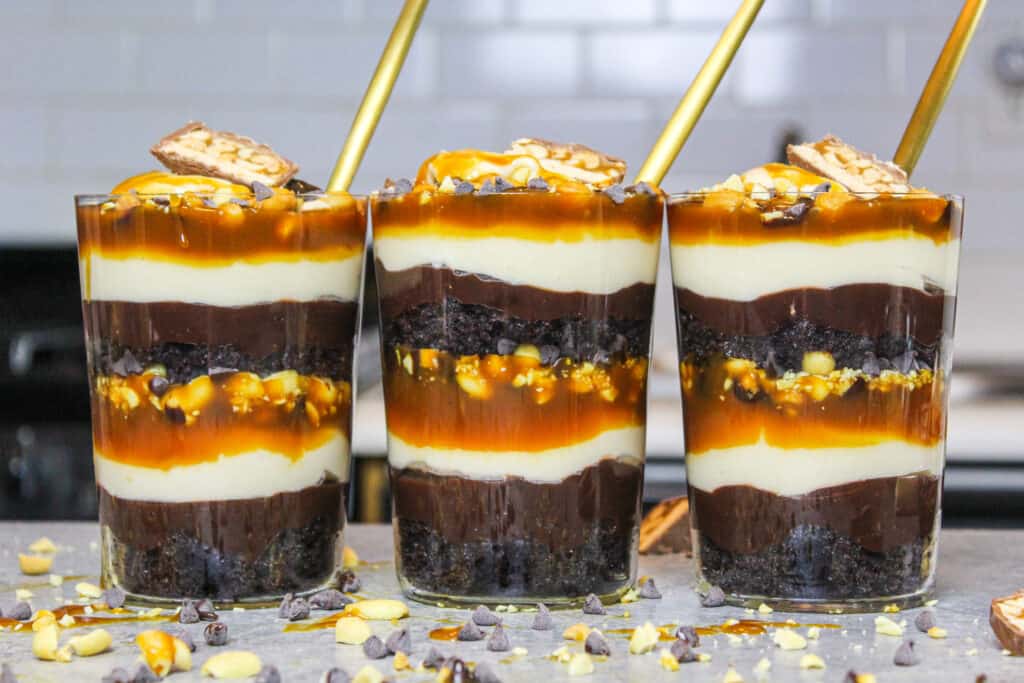
Snickers Trifle
Let Me Know What You Call up!
If you try this blue mirror glaze recipe, I'd love to hear what you call back of it! Please leave a rating on the recipe card below.
Also be sure to tag me @chelsweets and #chelsweets, then I can run into your beautiful creations on social media!
Prep Time 30 minutes
Cook Time 34 minutes
Additional Fourth dimension two hours
Full Time 3 hours 4 minutes
Ingredients
Vanilla Block Recipe
- 3 cups all-purpose flour (390 grams)
- 3 cups granulated sugar (600 grams)
- 2 1/ii tsp blistering powder (10 grams)
- i tsp salt (vi grams)
- 1 cup unsalted butter, room temperature (226 grams) - 2 sticks
- ane loving cup pasteurized egg whites from a carton (or almost seven egg whites) (235 grams)
- 1 1/two cups buttermilk or sour cream, room temperature (345 grams)
- 2 Tbsp vegetable oil (28 grams)
- ii tsp vanilla extract (8 grams)
- Blue gel food coloring (if desired)
Vanilla Buttercream Frosting
- 2 cups unsalted butter, room temperature (454 grams)
- 1 Tbsp vanilla extract or vanilla bean paste (12 grams)
- 1 tsp salt (vi grams)
- 7 cups powdered carbohydrate (875 grams)
- i/iv cup heavy cream (or whipping foam) (lx grams)
Mirror Coat Recipe
- 2 1/2 tsp or 1 envelope of powdered unflavored gelatin (7 grams), bloomed in one/iv cup of additional water
- 1 1/2 cups granulated sugar (300 grams)
- 3/4 loving cup water, room temp (180 grams)
- two/iii cup sweetened condensed milk (200 grams)
- 1 2/iii loving cup white chocolate chips, melted (300 grams)
- one/2 tsp titanium dioxide or white gel food coloring
- Blue gel nutrient coloring
Additional Decorations – Optional
- Graham cracker crumbs
- White fondant
- Small silicone seashell mold
Equipment Needed
- 8-inch cake pans
- Spinning cake stand
- 8-inch cake lath
- Large offset spatula
- Bench Scraper
- Electric mitt mixer
- Microwave
- Mesh Strainer
- Digital thermometer
- Rimmed baking tray
Instructions
Vanilla Block Layers:
- Preheat oven to 350°F. Line three 8" cake pans with parchment rounds and grease with non-stick blistering spray.
- Mix together three cups all-purpose flour, 3 cups sugar, 2 i/two tsp baking powder and ane tsp salt in a stand mixer with a paddle attachment or hand mixer until fully combined.
- Mix in 1 cup of unsalted butter slowly into the dry ingredients on a low speed. Continue to mix until no large chunks of butter remain and the mixture looks crumbly.
- Pour in 1 cup of egg whites and mix on depression until merely incorporated. Mix in 1 i/2 cups buttermilk in two installments, on a depression speed.
- Add together in ii Tbsp of vegetable oil and 2 tsp of vanilla extract and mix at a low speed until fully incorporated.
- If you plan to color your cake layers, add in the gel food coloring with the vanilla and oil.
- Scrape down the sides of the bowl with a rubber spatula, then beat on a depression speed for most xxx seconds to brand sure everything is properly mixed together.
- Dissever the concoction evenly between your prepared pans. Bake for 33-35 minutes or until a toothpick comes out with a few moist crumbs.
- Let the pans to cool for 10 minutes, then run a small first spatula around perimeter of the pan to split the cake from the pan.
- Place cake layers into the freezer for 30 minutes to accelerate the cooling process. Once the layers are fully cooled, carefully flip the pans and remove the layers.
- Use a serrated knife to level the tops of the layers correct before you plan to get together your block, or you can wrap and freeze them in you're making them in advance.
- If you brand these cake layers in accelerate and freeze them, allow them thaw for almost 20 minutes before making your cake. The cake layers should notwithstanding be slightly common cold to the touch, which will make it easier to assemble your cake.
Vanilla Buttercream Frosting:
- While the cake layers bake and cool, make the vanilla buttercream frosting.
- Trounce 2 cups of unsalted butter on a medium speed for xxx seconds with a paddle attachment, until shine.
- Mix in 1 Tbsp of vanilla excerpt or vanilla bean paste and i tsp salt on a depression speed.
- Slowly add in 7 cups of powdered sugar, i cup at a fourth dimension. Alternating with pocket-sized splashes of 1/4 cup of heavy cream.
- Continue to mix on depression speed for a few minutes, until the desired consistency is reached.
- If the frosting is too thick, add together in additional cream (ane TBSP at a time). If the frosting is too thin, add together in more than powdered sugar (quarter of a cup at a time).
- Comprehend the buttercream with plastic wrap once it's ready to
prevent crusting.
Assembling the Cake:
- Stack and frost cake layers on a greaseproof cake board the same size as the block layers.
- Add together an even layer of buttercream between each cake layer with a large get-go spatula.
- Add together a sparse coat of frosting effectually the block, fully embrace the cake layers.
- Shine using a demote scraper, then arctic the block in the refrigerator
(twenty minutes) or freezer (5 minutes) until the frosting is firm to the touch. - Add together a 2d, thicker layer of frosting to the cake, and smooth using a demote scraper. Place the cake in the refrigerator (1 hour) or freezer (15 minutes) until the frosting is totally chilled.
Mirror Glaze:
- While the cake chills, make the mirror glaze. Pour one 1/2 cups of granulated sugar, 3/iv cup of water, and two/iii loving cup sweetened condensed milk in a heatproof bowl.
- Heat for two minutes on high power in the microwave. Remove the mixture and stir.
- Mix 1 envelope of about ii 1/2 tsp gelatin in a small bowl with 1/4 loving cup of h2o. Let this sit down for a couple minutes until the gelatin is hydrated.
- Pour the bloomed gelatin into the sugar water and whisk until the gelatin is fully dissolved.
- Melt 1 2/three cup white chocolate in the microwave by heating in 30 second intervals, stirring between each interval. Once the white chocolate is fully melted, pour the chocolate into the warm gelatin mixture.
- Advisedly whisk mixture until fully combined. Cascade through a sieve to remove whatsoever chunks of un-melted chocolate or stubborn $.25 of gelatin, or blend with an immersion blender.
- Pour 50 grams of mirror glaze into a small bowl and mix in ane/two tsp of titanium dioxide. Prepare aside.
- Split up the remaining coat between three bowls – there should be about 350 grams per bowl. Color them dissimilar shades of blue using gel food coloring.
- Identify a chilled buttercream cake on height of a circular object smaller than the cake lath, and set this on tiptop of big, rimmed baking sail to grab the run-off coat.
- Once the coat has cooled to virtually 95 F /47 C it's ready to exist poured.
- Pour the darkest blue glaze onto the center of the cake, and then slowly piece of work out to the edges of the cake in a circular motion until the block is covered. Alternate the shades of blueish as you cascade them to create an ocean-inspired wait. Be sure to salve a little bit of each colour for the next step.
- One time the cake is fully covered, swipe a large offset spatula covered with the white mirror coat across the top of the cake to create a marbled look, then drizzle with a scrap of additional blue glaze.
- Permit the glaze continue to drip for well-nigh 10 minutes and so scrape away excess coat from the lesser of the cake lath using a modest beginning spatula.
- Add together crushed graham crackers around the base of the block and garnish with small-scale fondant seashells if desired.
Notes
I batch of this mirror glaze makes nigh 4 cups, which is more than enough glaze to encompass 1, eight inch layer cake.
If you plan to eat the cake within a few hours afterward pouring the glaze, leave information technology out at room temp.
If you cascade the glaze in advance, store the cake in the fridge. Remove the block from the fridge a couple hours before you lot plan to cut into information technology.
Make this mirror glaze ahead of time or save leftovers! Once it's made, wrap the bowl with plastic wrap shop in the fridge for up to a week.
To apply chilled glaze, heat the basin in to the microwave for fifteen-20 second intervals until information technology reaches the right consistency
Use leftover glaze to summit cupcakes, cookies, or even ice foam!
Diet Data
Yield
24 Serving Size
1
Amount Per Serving Calories 687 Full Fat 31g Saturated Fatty 18g Trans Fat 0g Unsaturated Fat 11g Cholesterol 74mg Sodium 339mg Carbohydrates 99g Cobweb 1g Sugar 85g Protein 5g
How Much The Glased Cake,
Source: https://chelsweets.com/blue-mirror-glaze-cake/
Posted by: knowlesalhas1988.blogspot.com


0 Response to "How Much The Glased Cake"
Post a Comment